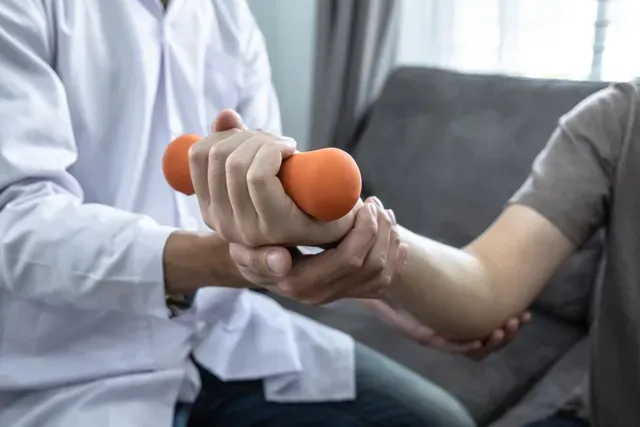At Back to You Osteopractic Physical Therapy & Rehabilitation in Royal Oak, Canton, and Grosse Pointe Woods, MI, the end goal for both Physical Therapy (PT) and Occupational Therapy (OT) is the same – helping you get “back to you”. There are many similarities between the two, but they also have distinct differences. PT focuses on improving your mobility and movement, primarily focusing on gross motor function and pain reduction throughout the entire body, especially the spine and lower extremities. OT focuses on executive functioning tasks to help you be as independent as possible with your everyday activities. These tend to primarily involve the upper extremity and cognition. This may require adaptive equipment, such as dressing or kitchen aids, and learning how to modify daily tasks to get your to-do list done safely and with less pain and more energy. OT also helps to improve planning, sequencing, and task-execution issues of cognition that can be associated with Traumatic Brain Injuries (TBI) such as after a motor vehicle accident (MVA) or stroke (CVA or TIA). OT can address difficulties with Instrumental Activities of Daily Living (IADLs) such as the ability to pay bills, generate a grocery list and shop, or plan a schedule/calendar. Both OT and PT offer rehabilitative exercises for strengthening and promoting healing, and manual therapy to improve range of motion and decrease pain. PT and OT often collaborate together to give our patients the best possible outcome.
Perhaps the best way to explain the difference is to present a big picture of one of our patients, who we’ll call Lucy.
- Pain: “Are you in pain?” “Do you have any discomfort?”
- Position: “Do you want me to help you move into a better position?”
- Placement: “Do you need anything to be placed within easy reach?”
- Personal needs: “Do you need anything to drink or eat?” “Do you want to go to the washroom?” (2)
Lucy came to us initially, two years ago, after an auto accident, and was primarily getting PT for her shoulder pain. While PT helped significantly, Lucy still required shoulder surgery which resulted in nerve damage to her brachial plexus. When Lucy came back to us after surgery, she was experiencing intense pain in her entire left arm and hand, which was excruciating with the slightest touch or stimuli, and was hypersensitive to heat, cold or different textures. This affected every aspect of her life, her everyday “occupations”: she was unable to work, drive, take care of household tasks, and needed assistance with dressing, bathing and all self care.
PT focused on Lucy’s shoulder complex, cervical (neck), and thoracic spine (torso), working toward getting movement back, calming down the nervous system and treating the pain around the upper arm. Treatment was heavy on manual therapy in the beginning- cupping, joint mobilizations, massage, dry needling, electrical stimulation.
OT focused on Lucy’s hand and forearm, working on calming down the nervous system and treating pain in the lower arm. These issues needed to be addressed before trying to get any movement back. In the beginning stages, we used desensitization techniques. We slowly re-introduced her to various temperatures and textures, including water beads, then to amounts of pressure with light manual therapy. We used mirror therapy, using exercises such as this, to help retrain the brain in movement patterns she had lost.
In the meantime, Lucy needed to be able to do her daily tasks. She had help at home, but needed and wanted to do some things herself, with the goal to be entirely independent in the future. The OT practitioners taught her ways to dress herself and perform other self care tasks without the typical use of her left arm. We ordered adaptive equipment and taught her how to use it so she could be more independent at home. Both OT and PT practitioners taught her pain management techniques, such as breathing, visualization and positioning for the affected areas, and ordered her an H-wave electrical stimulation unit to use at home.
Lucy showed progress with each OT and PT session. She eventually was able to tolerate touch and manual therapy to her hand and forearm. As a result, she was able to start doing exercises and become more independent at home, and eventually return to work part time with adaptations to her work space. Her strength and range of motion in her shoulder, arm and hand have improved greatly over the past year, and she is now working full time, and enjoys biking, working out at the gym, and even golfing. Both OT and PT practitioners are continuing to work with Lucy to meet all of her goals so she can do her daily activities without pain, and to fine tune her plan of care based on evidence-based research. Lucy continues to benefit from all of our manual therapy techniques including cupping, dry needling, instrument assisted soft tissue mobilization and body tempering.
With OT and PT collaborating, Lucy was able to get the best possible care to help her regain movement and function in her left arm and hand so she could do what she needed and wanted to do. Back to You Osteopractic Physical Therapy & Rehabilitation in Royal Oak, Canton, and Grosse Pointe Woods, MI has been honored to help her get back to Lucy!
REFERENCES:
Swan, M. E. (n.d.). Complex Regional Pain Syndrome (CRPS) Treatment: Desensitization. RSDSA. Retrieved September 13, 2022, from https://rsds.org/complex-regional-pain-syndrome-crps-treatment-desensitization/
What is Mirror Therapy?. (n.d.). Mirror Therapy. Retrieved September 13, 2022, from https://mirrortherapy.com/

